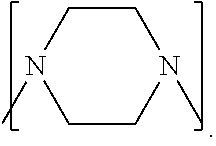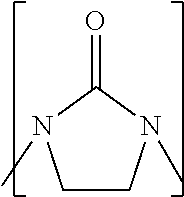Process to prepare higher ethylene amines or urea derivatives thereof
a technology of ethylene amine and urea derivative, which is applied in the preparation of organic compounds, chemical apparatus and processes, and organic chemistry. it can solve the problems of complex mixture, high cost, high flammability and carcinogenicity,
- Summary
- Abstract
- Description
- Claims
- Application Information
AI Technical Summary
Benefits of technology
Problems solved by technology
Method used
Image
Examples
example 1
Investigation of the Effect of Water in a System Containing a CO: Amine Ratio of 2:1
[0071]To investigate the effect of water on conversion rate and selectivity UAEEA and EU were mixed in a 1:1 molar ratio. Then 0, 1, 2, 4 or 8 molar equivalents of water were added to the mixture. Each of these mixtures was loaded into a reactor vessel and heated to 280 deg C. for two hours resulting in the conversion of UAEEA and EU to a TETA product mixture that is defined as the combined fraction of L-TETA and its terminal urea derivatives. After two hours of reaction time, the reaction mixture was cooled down and analyzed using GC-FID, which stands for gas chromatography using a flame ionization detector.
[0072]From the experimental results shown in Table 1 it becomes clear that the conversion level after two hours of reaction time at the same reaction temperature increases with an increase in water content. The addition of 1 molar equivalent of water (which corresponds with 0.5 molar equivalent o...
example 2
Investigation of the Effect of Water in a System Containing a CO: Amine Ratio of 1:1
[0075]To investigate the effect of water on conversion rate and selectivity AEEA and EU were mixed in a 1:1 molar ratio. Then 0, 1, or 4 molar equivalents of water were added to the mixture. Each of these mixtures was then loaded into a reactor vessel and heated to 280 deg C. for two hours resulting in the conversion of AEEA and EU to a TETA product mixture as defined in Example 1. After two hours of reaction time, the reaction mixture was cooled down and analyzed using GC-FID, which stands for gas chromatography using a flame ionization detector.
[0076]From the experimental results shown in Table 2 it becomes clear that the finding that conversion increases at a higher H2O level until ratio H2O / CO=2, yet selectivity decreases, is confirmed also by this Example. The addition of 1 molar equivalent of water to a mixture of AEEA and EU results in a significant increase in conversion from 35% to 58%. The ...
example 3
Investigation of the Effect of Water on Selectivity in a System Containing a CO:Amine Ratio of 2.7:2 (1.35:1)
[0077]To investigate the effect of water on selectivity UAEEA, EU and EDA were mixed in a 1:1.7:0.3 molar ratio. Then 1, and 4 molar equivalents of water were added to the mixture, because of the 2.7 equivalent of urea units resulting in a water:carbon oxide delivering agent of respectively 0.37:1 and 1.48:1. Each of these mixtures was then loaded into a reactor vessel and heated to 270 deg C. for two hours resulting in the conversion of UAEEA and EDA to a TETA product mixture. After two hours of reaction time, the reaction mixture was cooled down and analyzed using GC-FID, which stands for gas chromatography using a flame ionization detector.
[0078]From the experiments in Table 3 it becomes clear that a good balance between conversion and selectivity is achieved performing the process with the right molar amount of water.
TABLE 3StartingReactionTemp.H2O / CO#mixturetime (hr)(C.)...
PUM
| Property | Measurement | Unit |
|---|---|---|
| Temperature | aaaaa | aaaaa |
| Fraction | aaaaa | aaaaa |
| Fraction | aaaaa | aaaaa |
Abstract
Description
Claims
Application Information
 Login to View More
Login to View More - R&D
- Intellectual Property
- Life Sciences
- Materials
- Tech Scout
- Unparalleled Data Quality
- Higher Quality Content
- 60% Fewer Hallucinations
Browse by: Latest US Patents, China's latest patents, Technical Efficacy Thesaurus, Application Domain, Technology Topic, Popular Technical Reports.
© 2025 PatSnap. All rights reserved.Legal|Privacy policy|Modern Slavery Act Transparency Statement|Sitemap|About US| Contact US: help@patsnap.com



